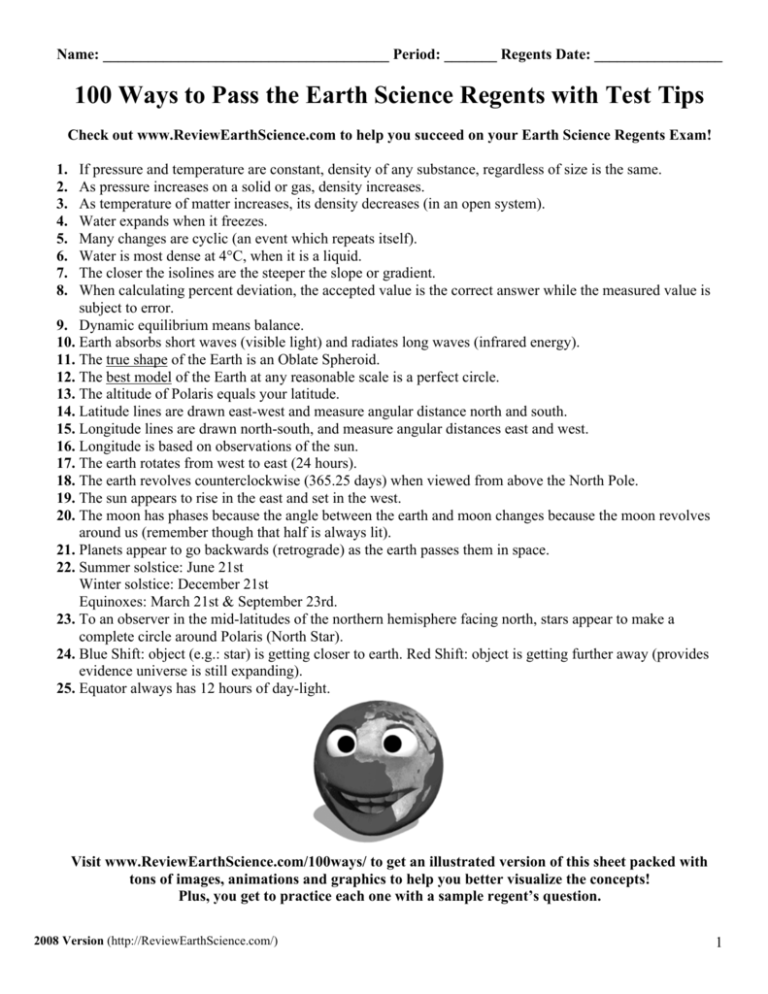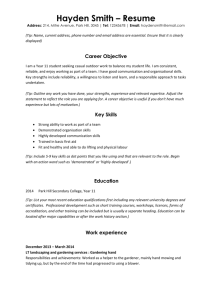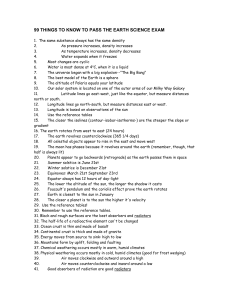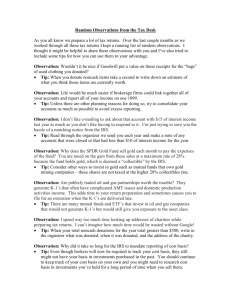100 Ways To Pass The Earth Science Regents
advertisement

Name: ______________________________________ Period: _______ Regents Date: _________________ 100 Ways to Pass the Earth Science Regents with Test Tips Check out www.ReviewEarthScience.com to help you succeed on your Earth Science Regents Exam! 1. 2. 3. 4. 5. 6. 7. 8. If pressure and temperature are constant, density of any substance, regardless of size is the same. As pressure increases on a solid or gas, density increases. As temperature of matter increases, its density decreases (in an open system). Water expands when it freezes. Many changes are cyclic (an event which repeats itself). Water is most dense at 4°C, when it is a liquid. The closer the isolines are the steeper the slope or gradient. When calculating percent deviation, the accepted value is the correct answer while the measured value is subject to error. 9. Dynamic equilibrium means balance. 10. Earth absorbs short waves (visible light) and radiates long waves (infrared energy). 11. The true shape of the Earth is an Oblate Spheroid. 12. The best model of the Earth at any reasonable scale is a perfect circle. 13. The altitude of Polaris equals your latitude. 14. Latitude lines are drawn east-west and measure angular distance north and south. 15. Longitude lines are drawn north-south, and measure angular distances east and west. 16. Longitude is based on observations of the sun. 17. The earth rotates from west to east (24 hours). 18. The earth revolves counterclockwise (365.25 days) when viewed from above the North Pole. 19. The sun appears to rise in the east and set in the west. 20. The moon has phases because the angle between the earth and moon changes because the moon revolves around us (remember though that half is always lit). 21. Planets appear to go backwards (retrograde) as the earth passes them in space. 22. Summer solstice: June 21st Winter solstice: December 21st Equinoxes: March 21st & September 23rd. 23. To an observer in the mid-latitudes of the northern hemisphere facing north, stars appear to make a complete circle around Polaris (North Star). 24. Blue Shift: object (e.g.: star) is getting closer to earth. Red Shift: object is getting further away (provides evidence universe is still expanding). 25. Equator always has 12 hours of day-light. Visit www.ReviewEarthScience.com/100ways/ to get an illustrated version of this sheet packed with tons of images, animations and graphics to help you better visualize the concepts! Plus, you get to practice each one with a sample regent’s question. 2008 Version (http://ReviewEarthScience.com/) 1 26. The lower the altitude of the sun, the longer the shadow it casts. 27. The Coriolis Effect results from the earth's rotation. The Foucault Pendulum illustrates the Coriolis Effect, and so 'proves' the earth's rotation. 28. Earth is closer to the sun in the winter. 29. The closer the planet is to the sun the higher it's velocity and the further the planet is from the sun, the slower its velocity. 30. The sun is one foci on an ellipse. There is nothing at the other foci. 31. Black objects absorb energy and white objects reflect. 32. Apparent diameter of objects (sun, moon) gets larger when the object is closer to Earth. 33. Vertical rays (overhead sun) can only occur between 23.5°N and 23.5°S. 34. Be Familiar with this chart DATE LATITUDE OF SUN'S DIRECTION OF ALTITUDE OF LENGTH OF (APPROXIMATE) DIRECT RAYS SUNRISE AND SUNSET NOON SUN DAYLIGHT Sept. 23 (Autumnal Equinox) Equator (0°) Rises due East Sets due West 48° 12 hours December 21 (Winter Solstice) Tropic of Capricorn (23.5°S) Rises in South East Sets in South West 24.5° (lowest) 8 hours (shortest day) March 21 (Vernal Equinox) Equator (0°) Rises due East Sets due West 48° 12 hours June 21 (Summer Solstice) Tropic of Cancer (23.5°N) Rises in North East Sets in North West 71.5° (highest) 16 hours ( longest day) 35. Winds curve to the right in the northern hemisphere and to the left in the southern hemisphere due to the earth rotation. Called the Coriolis Effect. 36. Energy moves from source to sink: high to low. 37. Air moves clockwise and outward around a high. 38. Air moves counterclockwise and inward around a low. 39. Good absorbers of radiation are good radiators. 40. Hottest part of the year is in July in the Northern Hemisphere. 41. Hottest part of the day is after 1:00p.m. 42. As temperature increases, air pressure decreases. 43. As atmospheric moisture (humidity) increases, atmospheric pressure decreases. 44. Air pressure decreases with altitude. 45. Cooler and drier air generally exerts higher pressure. Warm, moist air generally exerts lower pressure. 46. Wind is the result of pressure differences. 47. Wind blows from high to low pressure. 48. Wind is named for the direction that it is coming from. 49. The closer the air temperature is to the dew point the greater the chance for precipitation. 50. Weather moves from west to east in the United States. Test your knowledge of these concepts and have a little fun. Visit www.ReviewGameZone.com/100ways/ to play games and learn earth science! 2008 Version (http://ReviewEarthScience.com/) 2 51. Generally, with the passage of a cold front, the temperature and humidity decrease, the pressure rises. 52. Generally, with the passage of a warm front, the temperature and humidity increase, the pressure decreases. 53. Occluded front is formed when a cold front overtakes a warm front. 54. Cold fronts move the fastest. 55. As air rises, it expands and cools. 56. Porosity does not depend on particle size. 57. As particle size increases, permeability increases. 58. Capillarity increases when particle size decreases. 59. Ep (potential evapotranspiration) depends on temperature. 60. Water bodies moderate temperature. 61. Adiabatic cooling occurs as rising air expands. The air expands because the pressure on it is decreasing. 62. Most surface water runoff occurs if the soil is bare, precipitation rate exceeds permeability rate, soil is saturated and slope of land is too great. 63. Chemical weathering dominates in warm, humid climates. 64. Physical Weathering dominates in cold, humid climates (good for frost wedging). 65. Gravity is the force that drives erosion. 66. Streams are currently the number one agent of erosion in New York State. 67. Stream velocity depends on slope (gradient) and discharge. 68. Velocity is greatest on the out side of meander bend. 69. Heavy, round and dense particle settle out first. 70. Water sorts sediments by size vertically, with the biggest sentiments on the bottom only when sediments settle in still water. 71. Isostasy: earth's crust in equilibrium. 72. Unconformity is a buried erosion surface that represents a gap in the rock record. 73. The four principal types of drainage pattern are related to the underlying regional geology. They are: Dendritic (random), Rectangular, Radial and Trellis (block). 74. When a rock is broken into smaller pieces, surface area increases and weathering rate increases. 75. Mineral properties depend on internal atomic arrangement. Visit www.ReviewEarthScience.com/100ways/ to get an illustrated version of this sheet packed with tons of images, animations and graphics to help you better visualize the concepts! Plus, you get to practice each one with a sample regent’s question. 2008 Version (http://ReviewEarthScience.com/) 3 76. Ocean crust is thin, dense and basaltic. 77. Continental crust is thick, less dense and granitic. 78. Sedimentary rocks commonly layered and almost all fossils form in sedimentary environments. 79. Igneous rock: cools fast: small crystals; cools slow: large crystals. 80. Metamorphic- banded-distorted structure. 81. The silicon (Si) oxygen (O) tetrahedron is the building block of silicate minerals, the most abundant in earth's crust. 82. Arid landscape: steep slopes with sharp angles. 83. Humid landscape: smooth with rounded slopes. 84. Mid-ocean ridge - new earth being created-sea floor spreading. 85. Trenches - earth being destroyed - subduction zone. 86. P waves are faster than S waves. 87. P-waves pass through liquids, solids and gases (that's why people hear earthquakes. "S"-waves travel through "s"olids only. 88. You need 3 seismometer stations to triangulate the epicenter of an earthquake. 89. Convection currents in the mantle move plates. 90. The orientation of the Earth's magnetic field has reversed with time. 91. Plate tectonics states the earth's crust is broken into plates which can move. 92. Three main types of plate boundaries: convergent, divergent and transform. 93. Mountains form by uplift. 94. The half-life of a radioactive element can't be changed. 95. Index fossils are good time markers (widely spread, lived a short time). 96. Undisturbed strata - bottom layer is oldest. 97. Intrusion and faults are younger than the rock they are in. 98. Uranium 238 (U 238) dates old rocks. 99. Carbon 14 dates recent living objects. 100. Use your Earth Science Reference Tables! This is one of the most important tools in your test taking arsenal. TIP: Use the reference tables! Ask yourself: Is it in the reference tables, or can the reference tables help me? TIP: Look up formulas, even if you think you know them. Substitute information from the question into the formula. Many of them are on the reference tables. TIP: Draw diagrams to help you visualize the questions asked - where possible. TIP: Read introductory paragraphs and study diagrams before looking at questions. Underline key words. Read all choices before deciding on an answer, sometimes a question has a good and a better answer. Always choose the best answer. TIP: If you are not sure of an answer, try to eliminate choices that you think are clearly wrong and narrow down your choices. Then make your most careful guess. TIP: Skip over hard questions that are stumping you. Go back to them later. Something else in the test may give you a clue to the harder problems. TIP: Don't leave any questions blank. Check your test a second time, but only change an answer if you find an obvious mistake. Your first choice is usually correct. TIP: Take your time. You have three hours to do the exam. TIP: Relax-you've seen all this stuff before and you've already completed 1/4 of the exam. TIP: Have a healthy meal for dinner the night before and a good night sleep is as important as the above items. Test your knowledge of these concepts and have a little fun. Visit www.ReviewGameZone.com/100ways/ to play games and learn earth science! 2008 Version (http://ReviewEarthScience.com/) 4






